Abstract
During batch fermentation, the rate of ethanol production per milligram of cell protein is maximal for a brief period early in this process and declines progressively as ethanol accumulates in the surrounding broth. Our studies demonstrate that the removal of this accumulated ethanol does not immediately restore fermentative activity, and they provide evidence that the decline in metabolic rate is due to physiological changes (including possible ethanol damage) rather than to the presence of ethanol. Several potential causes for the decline in fermentative activity have been investigated. Viability remained at or above 90%, internal pH remained near neutrality, and the specific activities of the glycolytic and alcohologenic enzymes (measured in vitro) remained high throughout batch fermentation. None of these factors appears to be causally related to the fall in fermentative activity during batch fermentation.
Full text
PDF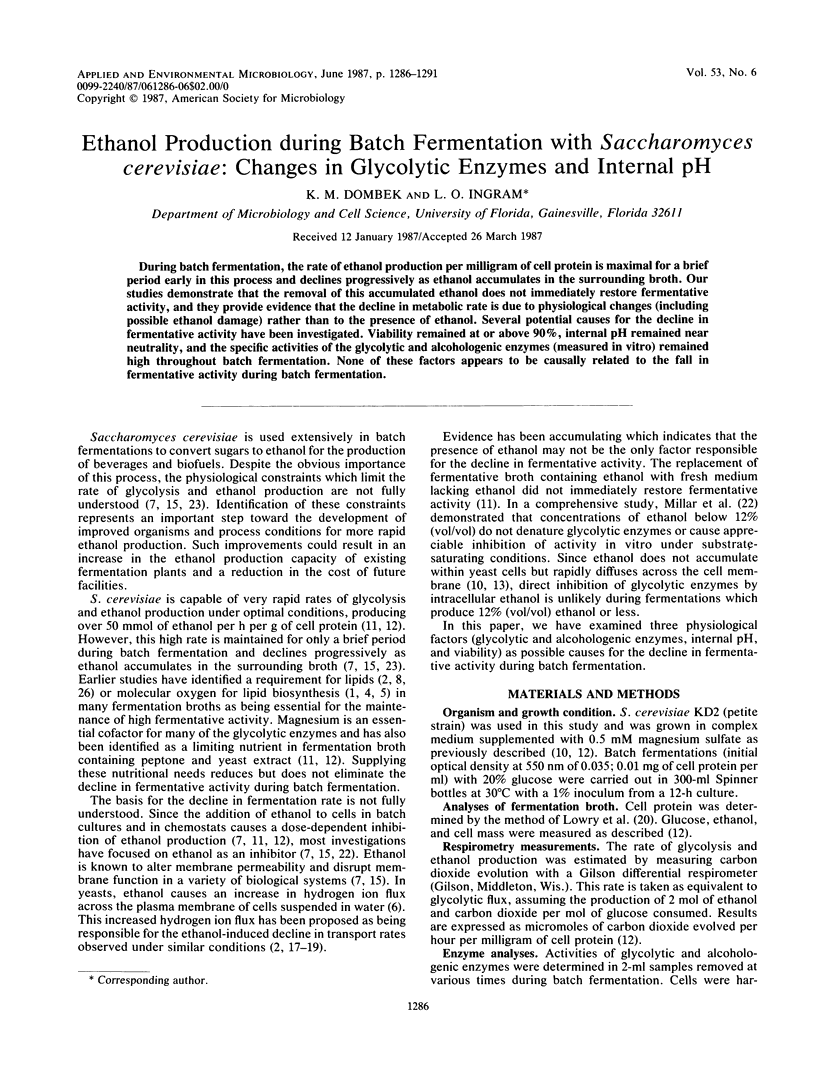
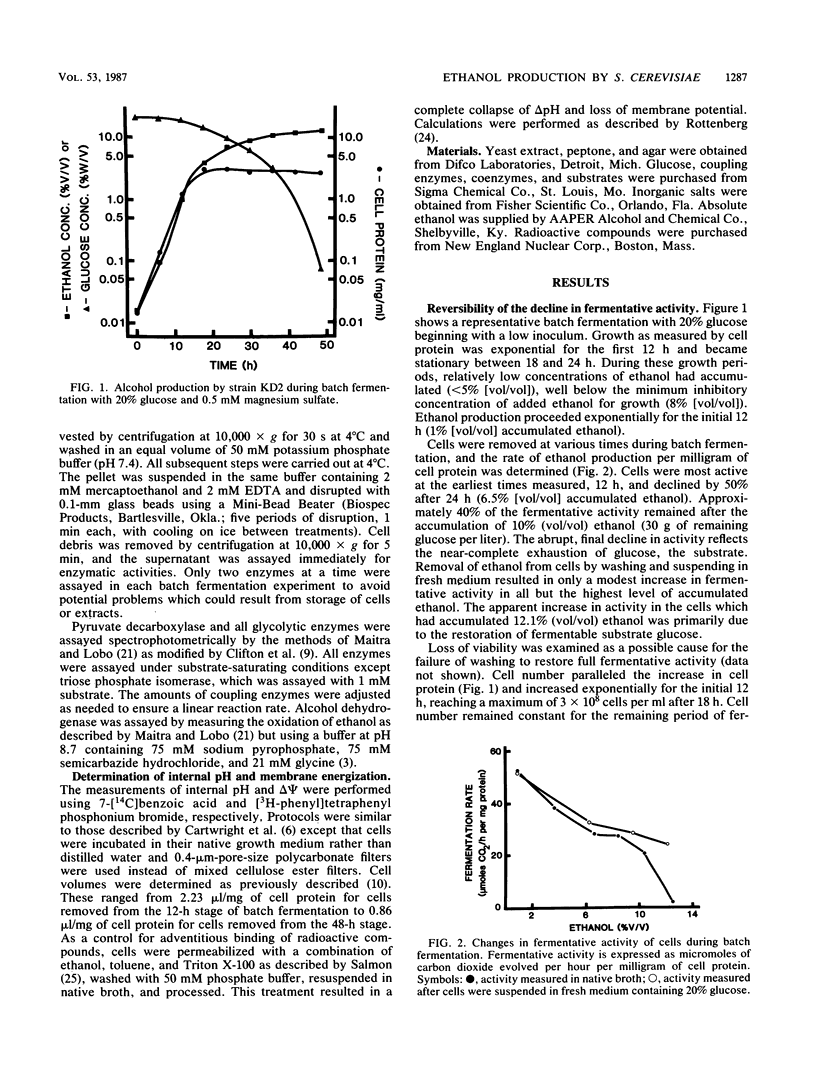
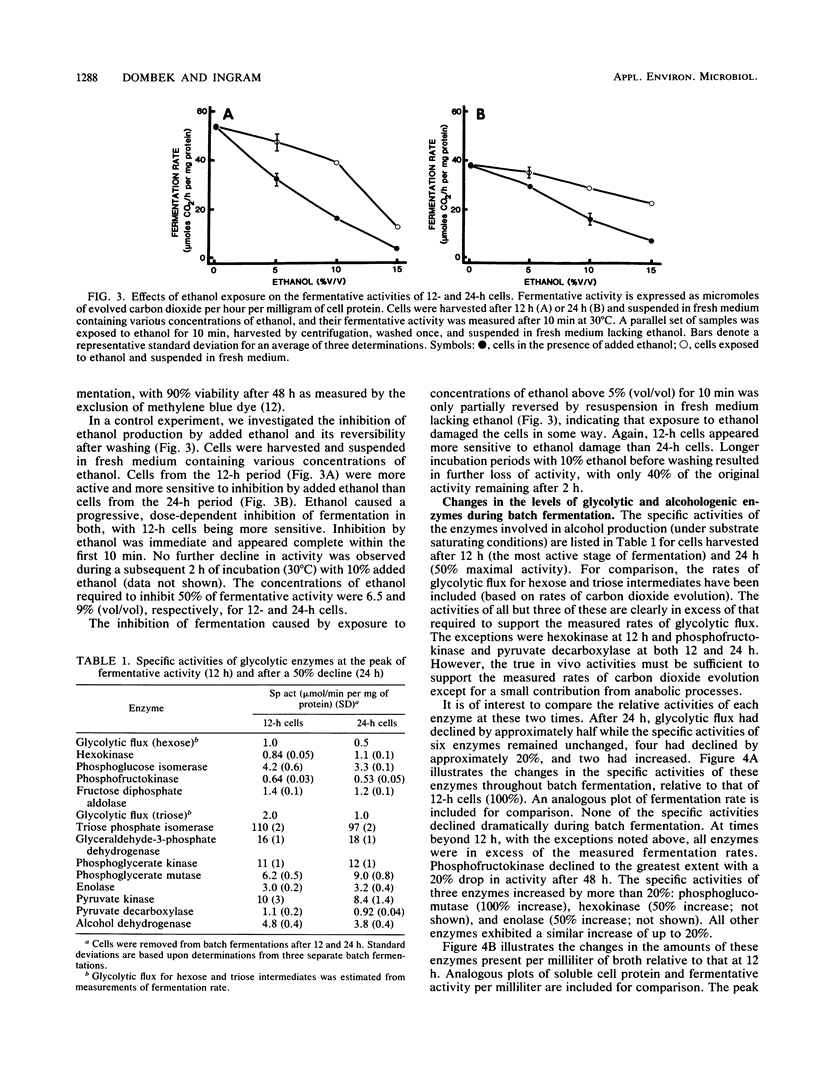
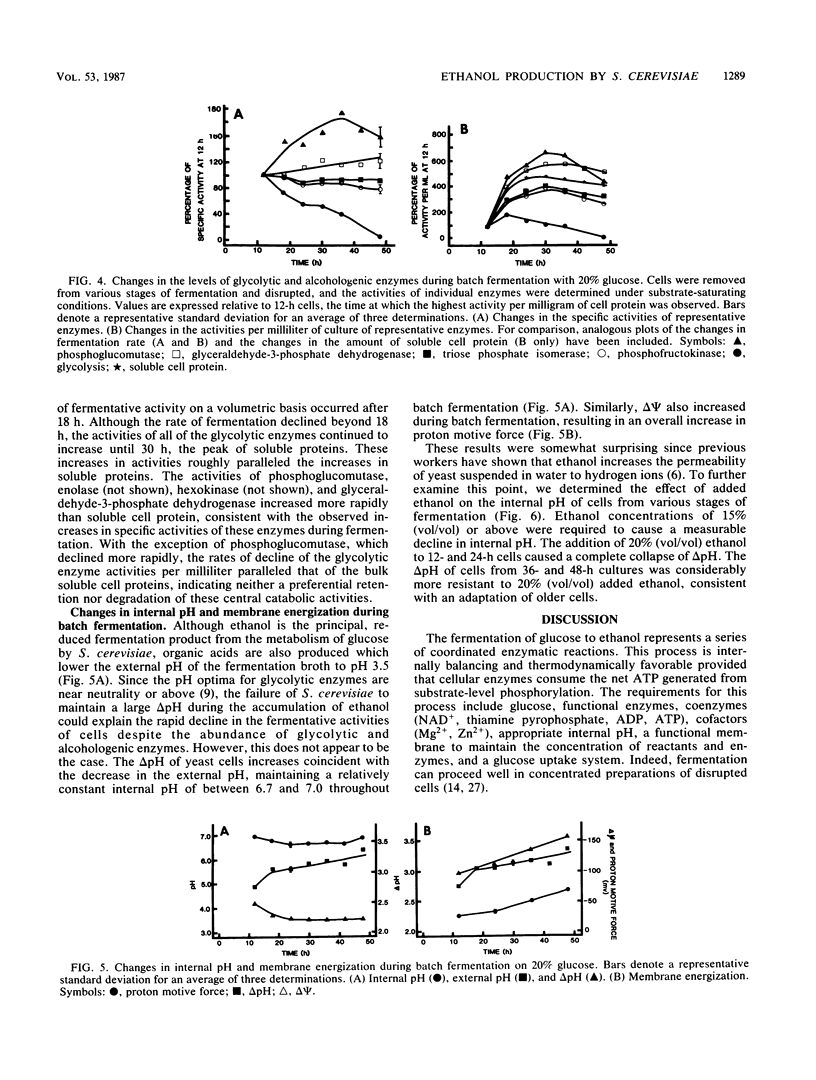
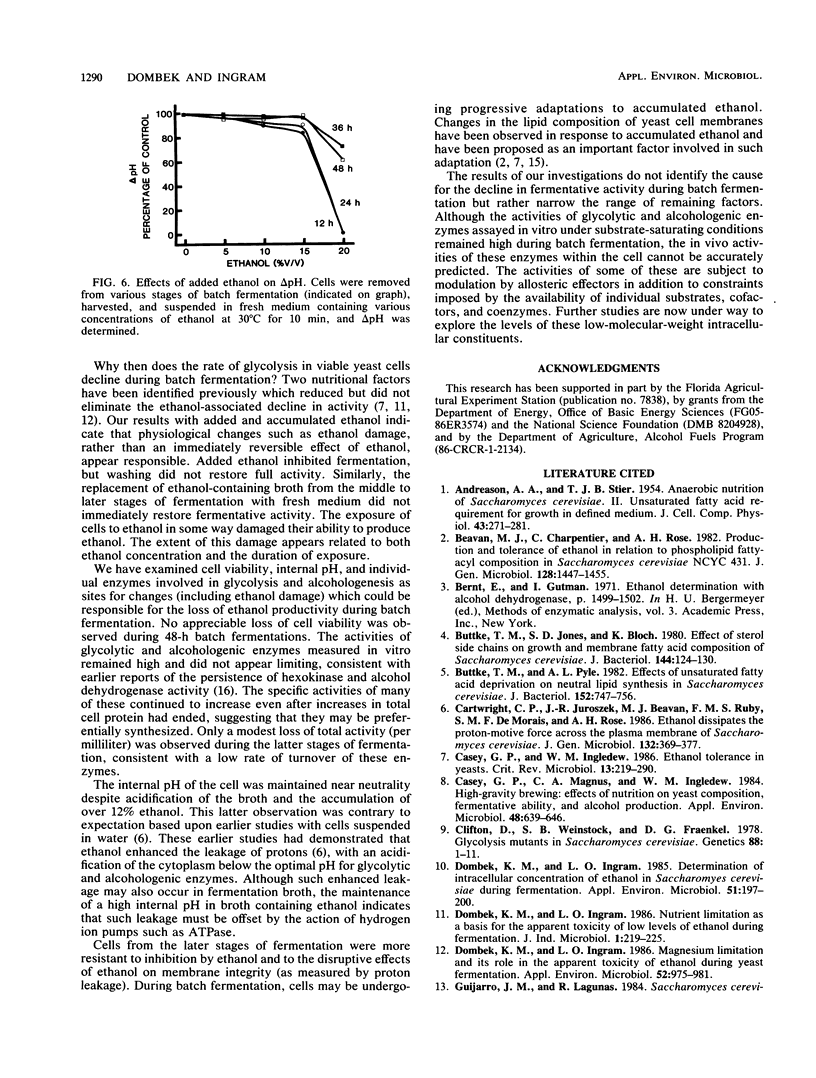
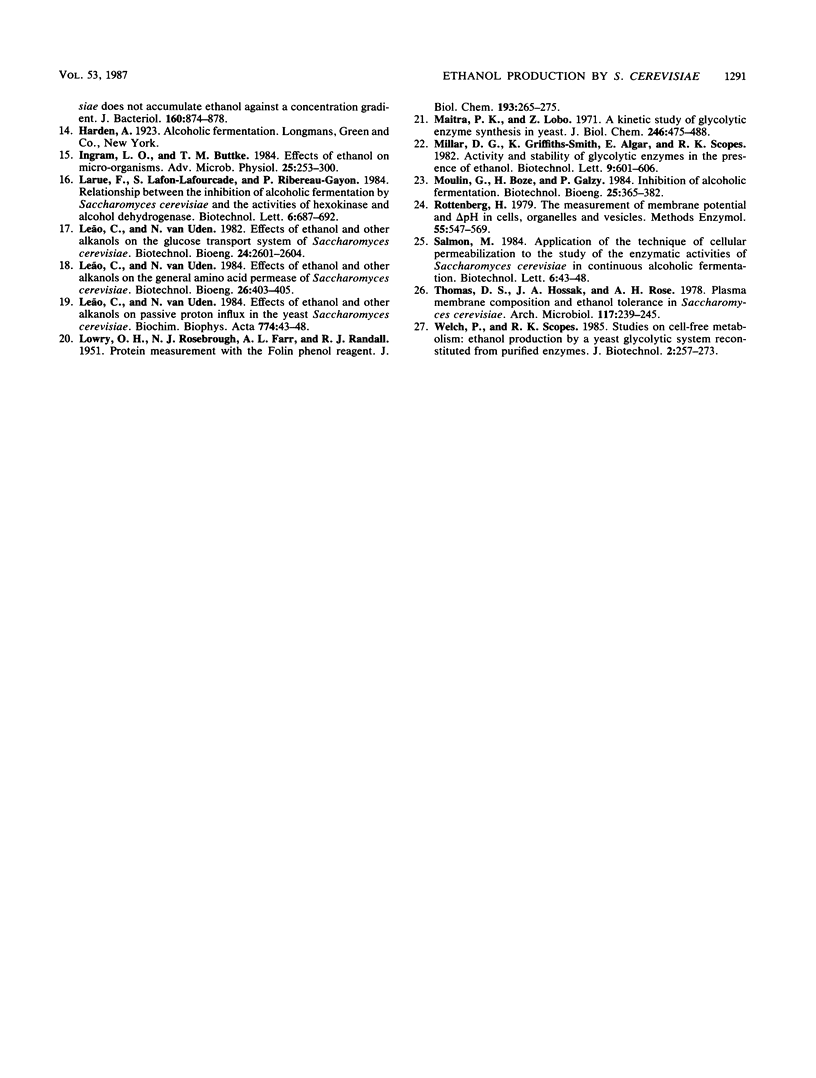
Selected References
These references are in PubMed. This may not be the complete list of references from this article.
- ANDREASEN A. A., STIER T. J. Anaerobic nutrition of Saccharomyces cerevisiae. II. Unsaturated fatty acid requirement for growth in a defined medium. J Cell Physiol. 1954 Jun;43(3):271–281. doi: 10.1002/jcp.1030430303. [DOI] [PubMed] [Google Scholar]
- Buttke T. M., Jones S. D., Bloch K. Effect of sterol side chains on growth and membrane fatty acid composition of Saccharomyces cerevisiae. J Bacteriol. 1980 Oct;144(1):124–130. doi: 10.1128/jb.144.1.124-130.1980. [DOI] [PMC free article] [PubMed] [Google Scholar]
- Buttke T. M., Pyle A. L. Effects of unsaturated fatty acid deprivation on neutral lipid synthesis in Saccharomyces cerevisiae. J Bacteriol. 1982 Nov;152(2):747–756. doi: 10.1128/jb.152.2.747-756.1982. [DOI] [PMC free article] [PubMed] [Google Scholar]
- Casey G. P., Ingledew W. M. Ethanol tolerance in yeasts. Crit Rev Microbiol. 1986;13(3):219–280. doi: 10.3109/10408418609108739. [DOI] [PubMed] [Google Scholar]
- Casey G. P., Magnus C. A., Ingledew W. M. High-gravity brewing: effects of nutrition on yeast composition, fermentative ability, and alcohol production. Appl Environ Microbiol. 1984 Sep;48(3):639–646. doi: 10.1128/aem.48.3.639-646.1984. [DOI] [PMC free article] [PubMed] [Google Scholar]
- Clifton D., Weinstock S. B., Fraenkel D. G. Glycolysis mutants in Saccharomyces cerevisiae. Genetics. 1978 Jan;88(1):1–11. doi: 10.1093/genetics/88.1.1. [DOI] [PMC free article] [PubMed] [Google Scholar]
- Dombek K. M., Ingram L. O. Determination of the intracellular concentration of ethanol in Saccharomyces cerevisiae during fermentation. Appl Environ Microbiol. 1986 Jan;51(1):197–200. doi: 10.1128/aem.51.1.197-200.1986. [DOI] [PMC free article] [PubMed] [Google Scholar]
- Dombek K. M., Ingram L. O. Magnesium limitation and its role in apparent toxicity of ethanol during yeast fermentation. Appl Environ Microbiol. 1986 Nov;52(5):975–981. doi: 10.1128/aem.52.5.975-981.1986. [DOI] [PMC free article] [PubMed] [Google Scholar]
- Guijarro J. M., Lagunas R. Saccharomyces cerevisiae does not accumulate ethanol against a concentration gradient. J Bacteriol. 1984 Dec;160(3):874–878. doi: 10.1128/jb.160.3.874-878.1984. [DOI] [PMC free article] [PubMed] [Google Scholar]
- Ingram L. O., Buttke T. M. Effects of alcohols on micro-organisms. Adv Microb Physiol. 1984;25:253–300. doi: 10.1016/s0065-2911(08)60294-5. [DOI] [PubMed] [Google Scholar]
- LOWRY O. H., ROSEBROUGH N. J., FARR A. L., RANDALL R. J. Protein measurement with the Folin phenol reagent. J Biol Chem. 1951 Nov;193(1):265–275. [PubMed] [Google Scholar]
- Leão C., Van Uden N. Effects of ethanol and other alkanols on passive proton influx in the yeast Saccharomyces cerevisiae. Biochim Biophys Acta. 1984 Jul 11;774(1):43–48. doi: 10.1016/0005-2736(84)90272-4. [DOI] [PubMed] [Google Scholar]
- Maitra P. K., Lobo Z. A kinetic study of glycolytic enzyme synthesis in yeast. J Biol Chem. 1971 Jan 25;246(2):475–488. [PubMed] [Google Scholar]
- Rottenberg H. The measurement of membrane potential and deltapH in cells, organelles, and vesicles. Methods Enzymol. 1979;55:547–569. doi: 10.1016/0076-6879(79)55066-6. [DOI] [PubMed] [Google Scholar]
- Thomas D. S., Hossack J. A., Rose A. H. Plasma-membrane lipid composition and ethanol tolerance in Saccharomyces cerevisiae. Arch Microbiol. 1978 Jun 26;117(3):239–245. doi: 10.1007/BF00738541. [DOI] [PubMed] [Google Scholar]


